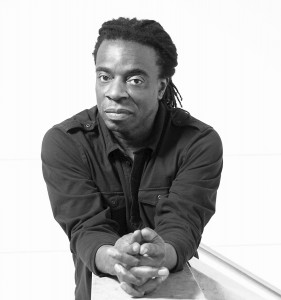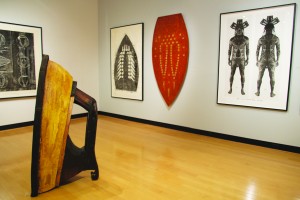Houghton College’s Ortlip Gallery is currently exhibiting the works of internationally known contemporary artist, Willie Cole. This collection spans over a 35 year period of Cole’s life and incorporates various forms of media, including: drawings, paintings, sculpture and prints. The exhibition, titled “Complex Conversations: Willie Cole Sculptures and Wall Works” gives light to the “urban African-American male experience,” according to Cole’s artist statement.
“Complex Conversations . . .” is a traveling exhibition, having already been shown at Western Michigan University, University of North Carolina at Greensboro, Elbert Art Center, and Grinnell College before arriving at Houghton College. The exhibition is curated by Patterson Sims, Chairman of the Board of Independent Curators International (ICI) and President of the Leon Polk Smith Foundation.
Cole’s work was introduced to Houghton College by Professor Jillian Sokso during the 2013-14 Faculty Lecture Series. In her lecture, Sokso examined the discourse of race, gender, and identity between the Cole’s work and African American artist Allison Saar. Sokso said Cole’s work “references African cultures and people groups. . . [also found] in the Hudgin’s Collection.”
The Hudgin’s Collection, donated by the late Charles Hudgins to Houghton College shortly before his passing in June 2011, consists of a wide assortment of African Art. A selection of this work is also available for viewing in the Center for the Arts Atrium at this time.
Cole’s artistic sensibility was noticed at an early age and only expanded as time went on. Cole was mainly influenced by exposure to the manipulation of objects through his father’s work as a factory mechanic, the African art and culture he studied at the School for Visual Arts in New York.
Cole’s work utilizes a variety of used consumer products such as irons, high-heels, hair dryers, and many other items. The use of domestic objects gives viewers a glimpse of Cole’s personal life, while remaining universally relatable.
Director of the Ortlip Gallery, Alicia Taylor. said, “Cole’s process creates an expansive dialog, exploring and transforming objects in a carefully crafted rhythm that prompts a shift in our perception. . . Pushing our sense of familiarity by converting household goods into symbols of culture, spirituality and politics, the work provides provocative and fresh entry points for connection”.
Cole’s artwork is currently represented through Alexander and Bonin, New York and is found around the world in numerous collections and museums, including the Museum of Modern Art in New York City, the National Gallery of Art in Washington D.C., the Art Gallery of Ontario in Toronto, and the FRAC-Lorraine in Metz, France. 
“Complex Conversations: Willie Cole Sculptures and Wall works” will be available to view in the Ortlip Gallery until October 15, Monday through Saturday, 9am to 6pm. A public reception will be held in the Center for the Arts Friday, September 12th at 7pm. Willie Cole will also be giving an artist lecture on Saturday, September 13 at 11:30 a.m. in the Recital Hall.
Taylor states “‘Complex Conversations . . .’ is not just for artists” and“such distinguished work on campus is an opportunity to challenge ourselves with engaging with the work, connecting with culture, and experience.”
Tag: washington d.c.
The smash hit political drama House of Cards came roaring back this year in its second season, continuing the story of Vice President Francis “Frank” Underwood’s lust for power.
The show takes it cue from Shakespeare’s Macbeth. Francis and his wife Claire do whatever is necessary to take control and gain power in Washington, D.C. The political drama has it all: violence, murder, sex, revenge, drug abuse, and political manipulation. The show is also an exposition of the relationships that occur outside the political realm. Relationships between characters blur from the Capitol Building to a small barbeque stand in the city, of which Frank is a frequent customer. All the characters have their demons and passions, leading their own lives to satisfy their own desires. But the many side-characters that exist in the show are merely pawns to Frank and Claire’s grand scheme to take control. And yet for all this excitement the show takes a very slow pace. Climaxes are slow to build and slow to diffuse.
In a way, House of Cards attempts to mimic real life. Unlike shows like 24, where the president is involved in gunfights and assassination attempts, House of Cards is more political, with gears slowly turning, plans slowly unraveling, paths crossing, and enemies slowly building ammunition. This is a show that takes patience, and pays off only a little at a time. Despite the plot’s sluggish unraveling, there are enough shocking scenes to keep the viewer asking for more. The first episode of Season 2 may be the most shocking thing you have ever seen on television. But you will have to experience that for yourself.

Season 2 picks up the show’s plot from where it left off at the end of Season 1. The first season follows Underwood’s ascension from Majority Whip in the House of Representatives to United States Vice President. At the end of Season 1, we are left wondering how characters will respond to Frank Underwood’s immoral behavior as well the fate of a number of characters whose lives hang in the balance. In Season 2, Underwood continues to strong-arm President Garret Walker to the chagrin of Raymond Tusk, the President’s billionaire best friend, in an effort to consolidate his influence within the White House. After Underwood wins over the president, Tusk seeks revenge by attacking the reputation of everybody Frank loves. Underwood is forced to control the damage of Tusk’s actions while still maintaining his own influence over President Walker and Congress.
The slow pace of House of Cards, has the advantage in allowing the viewer to see the development of each character. Francis, for example, is calculating, aware of his plan to seize power from the very beginning. He is ruthless, willing to do whatever it takes to further his own career. He plays whatever role he needs and there no limits to what he will do, and indeed, what he actually does. Claire is as calculating as her husband. She is Lady Macbeth, willing to sabotage anyone who stands in the way of her and her husband’s success. She is calm and seductive when she needs to be, but equally biting and harsh when the situation calls for it. Doug, Francis’ right-hand man, evokes a level of compassion that none of the other characters ever quite achieve. Among all of the backstabbing and power struggles, Doug appears to be the only one who is grappling with his own demons: alcoholism and sex. Yet his character is still guilty on some level in participating in his boss’s venomous power struggle and manipulation. Doug understands, however, that he is Frank’s pawn, and often tries to work that to his advantage.
But before you go and decide that all of this amoral power struggling is not for you, it is well worth noting the quality of the acting that Kevin Spacey, Robin Wright, Kate Mara, and the rest of the cast deliver. Spacey’s gentile southern accent will have you convinced that he was born with a southern drawl and raised to southern hospitality. The actors live into their characters so well, it will become hard for you to remember that these are actors, and not cogs in the political machine. If you decide to watch House of Cards for no other reason, do it for Spacey’s superb acting.
The show is not for the faint of heart, however. This is a Netflix original series, which means that it is barely regulated. The language is very strong, there are some instances of graphic violence, and some of the sex-scenes are borderline pornographic. Unlike Game of Thrones, however, there is no important information contained in those scenes of graphic sexuality so it is easy to skip them.
